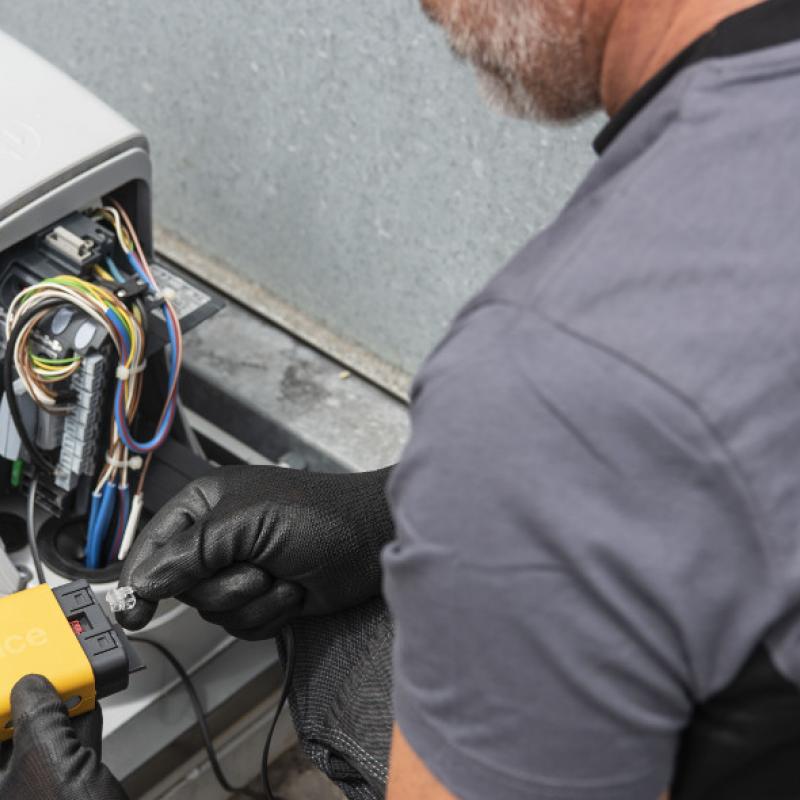Videos and FAQ
Era Mat A
Solution
FAQ
1) Which transmitters can I use to control Nice motors in the Era Mat A family to automate rolling shutters?
Era Mat A motors can be managed by the Era P, Era W, Era Miniway, Era P View, Era Touch, EraTime, NiceWay and TTX4 families of transmitters.
2) How can I associate the first transmitter with the Nice Era Mat A motor?
To associate the first transmitter with the Nice Era Mat A motor, follow the procedure shown in the video, or proceed as follows, respecting the sequence:
- Power the motor and wait for it to perform two movements.
- On the transmitter, select the channel you want to associate with the motor. If it is a single channel transmitter, go directly to the next step.
- Press and hold the STOP key and wait for the motor to perform 3 movements, then release.
The transmitter has been correctly associated.
3) How many transmitters can I associate with a Nice Era Mat A motor?
A maximum of 30 transmitters can be memorised for each Era Mat A motor.
4) What procedure should I follow to programme the upper and lower limit switches of the Nice Era Mat A motor?
The procedure to programme the positions of the limit switches of the Nice Era Mat A motor varies according to the characteristics of the application.
Manual adjustment is ideal for rolling shutters without safety plugs and without rigid anti-intrusion springs.
Semi-automatic adjustment is ideal for rolling shutters with safety plugs, but without rigid anti-intrusion springs, or for rolling shutters without safety plugs but with rigid anti-intrusion springs.
Automatic adjustment is ideal for rolling shutters with safety plugs and with rigid anti-intrusion springs.
5) What procedure should I follow to programme the limit switches of the Nice Era Mat A motor if it is installed in a rolling shutter without safety plugs and without rigid anti-intrusion springs?
For rolling shutters without safety plugs and without rigid anti-intrusion springs, the limit switches must be adjusted manually. This manual procedure can also be used for all other types of rolling shutter.
To adjust the limit switches of the Nice Era Mat A motor manually, follow the procedure shown in the video, or proceed as follows, respecting the sequence.
Position the rolling shutter at the midpoint, using the transmitter memorised previously.
Initially, the motor might move in the opposite direction to the one indicated on the arrow key of the transmitter. The motor will not automatically associate the correct direction until both the upper and lower limit switches have been set.
To set the upper limit switch, proceed as follows, respecting the sequence:
- Press and hold the UP ARROW or DOWN ARROW key on the transmitter until the rolling shutter is in the desired upper limit switch position, then release;
- Press and hold the STOP key and wait for the rolling shutter to perform two movements, then release;
- Press and hold the STOP key and wait for the rolling shutter to perform four movements, then release;
- Press and hold the UP ARROW key and wait for the rolling shutter to perform two movements, then release;
- Press and hold the STOP key and wait for the rolling shutter to perform three movements, then release.
To set the lower limit switch, proceed as follows, respecting the sequence:
- Press and hold the DOWN ARROW or UP ARROW key until the rolling shutter is in the desired lower limit switch position, then release;
- Press and hold the STOP key and wait for the rolling shutter to perform two movements, then release;
- Press and hold the STOP key and wait for the rolling shutter to perform four movements, then release;
- Press and hold the DOWN ARROW key and wait for the rolling shutter to perform two movements, then release;
- Press and hold the STOP key and wait for the rolling shutter to perform three movements, then release.
The upper and lower limit switches have been set correctly.
6) What procedure should I follow to programme the limit switches of the Nice Era Mat A motor if it is installed in a rolling shutter with safety plugs and with rigid anti-intrusion springs?
For rolling shutters with safety plugs and with rigid anti-intrusion springs, automatic limit switch adjustment is ideal.
Alternatively, the limit switches of the motor can be adjusted manually.
To adjust the limit switches automatically, proceed as follows, respecting the sequence:
- Position the rolling shutter at the midpoint, using the transmitter memorised previously;
- Press and hold the STOP key and wait for the rolling shutter to perform two movements, then release;
- Press and hold the STOP key and wait for the rolling shutter to perform four movements, then release;
- Press and hold the STOP key and wait for the rolling shutter to move upwards, then release.
If the rolling shutter moves downwards, press the UP ARROW or DOWN ARROW key briefly to invert the direction of the motor.
The rolling shutter will move upwards until the safety plugs strike the structure and the motor will save this position as the upper limit switch. - The rolling shutter will then move downwards until the rigid anti-intrusion springs intervene and it stops automatically. The motor will save this position as the lower limit switch.
The upper and lower limit switches have been set correctly.
7) What procedure should I follow to programme the limit switches of the Nice Era Mat A motor if it is installed in a rolling shutter with safety plugs and without rigid anti-intrusion springs?
For rolling shutters with safety plugs and without rigid anti-intrusion springs, semi-automatic limit switch adjustment is ideal.
Alternatively, the limit switches of the motor can be adjusted manually.
To adjust the limit switches of the motor semi-automatically, proceed as follows, respecting the sequence:
- Position the rolling shutter at the midpoint, using the transmitter memorised previously;
- Press and hold the UP ARROW or DOWN ARROW key and wait for the rolling shutter to move upwards and stop automatically when the safety plugs strike the structure, then release; the motor will save this position as the upper limit switch;
- Then press and hold the DOWN ARROW or UP ARROW key until the rolling shutter is about 5 cm from the desired lower limit switch position, then release;
- Press and hold the STOP key and wait for the rolling shutter to perform two movements, then release;
- Press and hold the STOP key and wait for the rolling shutter to perform four movements, then release;
- Press and hold the DOWN ARROW key and wait for the rolling shutter to perform two movements, then release;
- To fine adjust the desired lower limit switch position, press the UP ARROW and DOWN ARROW keys briefly; each time the key is pressed, the rolling shutter moves a few millimetres.
- When the lower limit switch position has been defined, press and hold the STOP key and wait for the motor to perform 3 movements, then release.
The upper and lower limit switches have been set correctly.
8) What procedure should I follow to programme the limit switches of the Nice Era Mat A motor if it is installed in a rolling shutter without safety plugs and with rigid anti-intrusion springs?
For rolling shutters without safety plugs and with rigid anti-intrusion springs, semi-automatic limit switch adjustment is ideal.
Alternatively, the limit switches of the motor can be adjusted manually.
To adjust the limit switches of the motor semi-automatically, proceed as follows, respecting the sequence:
- Position the rolling shutter at the midpoint, using the transmitter memorised previously;
- Then press and hold the UP ARROW or DOWN ARROW key until the rolling shutter moves up to about 5 cm from the desired upper limit switch position, then release;
- Press and hold the STOP key and wait for the rolling shutter to perform two movements, then release;
- Press and hold the STOP key and wait for the rolling shutter to perform four movements, then release;
- Press and hold the UP ARROW key and wait for the rolling shutter to perform two movements, then release;
- To fine adjust the desired upper limit switch position, press the UP ARROW and DOWN ARROW keys briefly; each time the key is pressed, the rolling shutter moves a few millimetres.
- When the upper limit switch position has been defined, press and hold the STOP key and wait for the motor to perform 3 movements, then release.
- Move the rolling shutter downwards by pressing and holding the DOWN ARROW or UP ARROW key and wait for the rolling shutter to stop automatically when the rigid anti-intrusion spring strikes the structure, then release.
The upper and lower limit switches have been set correctly.
9) What should I do if the rolling shutter does not move upwards when I send a raising command?
The motor may not be responding to the raising command because the rolling shutter is near the upper limit switch position. If this is the case, move the rolling shutter downwards briefly, then try sending the raising command again.
10) What should I do if the rolling shutter stops during a movement when no STOP command has been sent?
If the rolling shutter stops during a movement without having received any STOP command, make sure there are no obstacles or mechanical obstructions.
If there are no evident obstructions, you should adjust obstacle detection sensitivity.
After adjusting, check that the rolling shutter now moves correctly.
If the problem persists, adjust the motor limit switch again manually and set a sensitivity level of 4 (sensitivity deactivated).
11) What should I do if, when I send a command, the motor moves in the opposite direction from the one I want?
The motor will not automatically associate the correct direction until both the upper and lower limit switches have been set.
If the limit switches have already been set and the motor is still turning in the opposite direction to that indicated on the arrow key of the transmitter, delete the limit switch positions, then re-programme them using the correct procedure:
- manual adjustment in the case of rolling shutters without safety plugs and without rigid anti-intrusion springs;
- semi-automatic adjustment in the case of rolling shutters with safety plugs, but without rigid anti-intrusion springs, or rolling shutters without safety plugs but with rigid anti-intrusion springs;
- automatic adjustment in the case of rolling shutters with safety plugs and with rigid anti-intrusion springs.
12) What should I do if, when I power the motor, it performs a number of movements?
If the motor performs a number of movements when powered, this means that programming has not been completed. Verify and complete programming of the first transmitter and the limit switch positions.
13) What should I do if the motor blocks and does not respond to any command?
The motor has a thermal protection device which intervenes and stops it from moving when the temperature reaches a critical level or is too high.
Wait for the temperature to return to within the working limits.
Also make sure the motor is correctly powered and configured.
14) What should I do if, when I release the transmitter key, the motor stops and does not complete the manoeuvre?
The motor moves in "hold-to-run" mode until both the limit switch positions have been programmed. You therefore need to adjust the upper and lower limit switches.
15) What should I do if I have lost or damaged the only transmitter memorised in the motor?
If you have lost or damaged the only transmitter memorised in the motor, buy a new Nice transmitter with ARROW and STOP keys.
Use the new transmitter to reset the radio receiver of the motor to the default configuration, then proceed to memorise the first transmitter.

